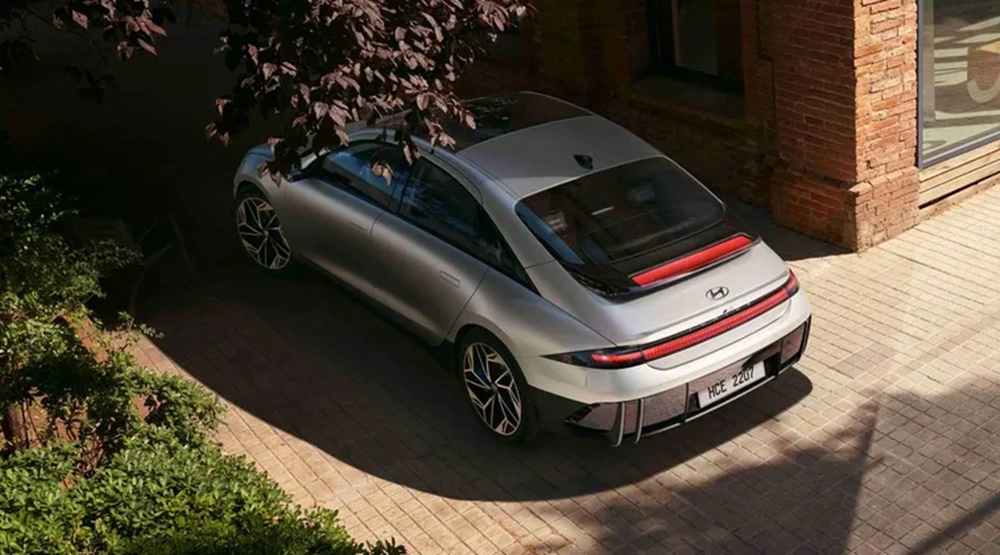Hyundai Ioniq 6 Features and Range revealed
600 km range: Competition for Tesla / Hyundai Ioniq 6 Features and Range revealed

Stromer growth at Hyundai: The Hyundai Ioniq 6 will strengthen the Koreans’ growing family of electric cars from the end of the year. Its range is impressive.
Hyundai has big plans when it comes to e-mobility: in eight years, the Koreans want to have eleven electric vehicles on offer. With the Ioniq 6, we will be launching our second all-electric model at the end of the year.
This is how he looks like
As with the 5 introduced in 2021, Hyundai goes its own way when designing the Ioniq 6, but deviates in large parts from the angular design of the 5.
The 6 is clearly not a sedan version of the hatchback Ioniq 5, but visually independent – even if it shares details such as the pixel graphics of the lights with it. Hyundai calls it “Streamliner”, based on the streamlined cars that came onto the market from the end of the 1930s.
The outer skin is emphatically aerodynamic with a roof line that stretches in a wide arc and extends far into the short rear rump. The nose sits significantly lower and is smoother, the Ioniq 6 really crouches on the road.
In addition, there are the door handles that are flush with the sheet metal skin and the small camera holders in the front doors, which serve as a replacement for the exterior mirrors. The reward for the effort is a low drag coefficient of 0.21 (Ioniq 5: 0.28).
This is what the Hyundai Ioniq 6 offers
At 4.86 meters, the Ioniq 6 is over 20 centimeters longer than the Ioniq 5, while its wheelbase is five centimeters shorter at 2.95 meters. Despite the roof sloping towards the rear, the rear offers plenty of legroom as well as good headroom. Hyundai emphasizes that the seats are around 30 percent thinner than in comparable models, but should still be comfortable. That creates more space.
The 6 is also characterized by a flat floor throughout and, in the optional four-seater version, a continuous center console. The interior pleases, among other things, with surfaces partly made of recycled plastic, with a tidy cockpit and a homely atmosphere.
Reduction is the motto here: the doors have no buttons, the buttons for the window regulators, for example, are located in the center console. A laptop can also be placed on it when the charging break is used for work. There are also 220-volt sockets on board.
Another special feature: instead of the Hyundai-H, there are four central lighting elements on the steering wheel. They give visual feedback from voice recognition and also provide information about the charge status. If you look at Morse code, four dots stand for the letter H.
In addition to the two optional monitors for the camera-based exterior mirrors, the cockpit also offers two 12-inch displays on the dashboard. The display behind the steering wheel is primarily for driving-related information, the touchscreen located to the right is responsible for pretty much everything else.
When it comes to assistants, the Hyundai is up to date: it parks independently, helps when changing lanes, otherwise stays in lane, recognizes traffic signs and crossing traffic when parking.
His technique can do that
There are several engine and battery packs to choose from. The long-range 77.4 kWh battery is available with rear-wheel drive or all-wheel drive. The top model offers a system output of 325 hp and 605 Nm of torque and only needs 5.1 seconds for the sprint from 0 to 100 km/h.
One of the most important distinguishing features of the Ioniq 6 compared to the 5 is its range: At up to 610 kilometers, the version with the 77.4 kWh battery is around 100 kilometers longer than its angular brother with the 72.6 kWh battery. It competes with the Tesla Model 3 (602 kilometers) and the VW ID.3 (550 kilometers). Among other things, the body shape and adjustments to the battery and the control system contribute to such values. In addition, the Ioniq can be updated “over the air”: The latest software is loaded directly via wireless Internet.
With Hyundai’s E-GMP architecture as the technical basis and 800-volt technology, the Hyundai charges its battery from 10 percent to 80 percent of its capacity in 18 minutes at a 350-kW charging station.
It should cost that
The costs are still uncertain, but the price could be similar to a comparably motorized Ioniq 5 (at least 41,900 euros).
The family grows
The presentation also featured the Seven Concept, a study for an Ioniq SUV. The next model to be launched is the sporty N variant of the Ioniq 5. Are these also available for the Ioniq 6? At least they didn’t want to rule it out when asked.
Renault increases prices for popular e-car / Automobile News


